 THE MINERAL PURPURITE
THE MINERAL PURPURITE
- Chemistry: MnPO4, Manganese Phosphate
- Class: Phosphates
- Uses: Only as a mineral specimens.
Specimens
The alteration is an oxidation reaction with the manganese ion going from a positive two (+2) charge in lithiophyllite to an ion with a positive three (+3) charge in purpurite. With the change in charge in the manganese ion, the lithium ion is then lost. Often some of the original lithiophyllite is still present in most purpurite specimens. The purple color or purpurite is truly unique in the mineral rainbow.
PHYSICAL CHARACTERISTICS:
- Color is purple (hence the name).
- Luster is vitreous to sub-metallic.
- Transparency: Crystals are translucent to opaque.
- Crystal System is orthorhombic; 2/m2/m2/m
- Crystal Habits generally are massive grains or crusts.
- Cleavage is good in one and poor in another direction.
- Fracture is uneven.
- Hardness is 4 - 4.5.
- Specific Gravity is approximately 3.3 (above average)
- Streak is deep red to purple.
- Other Characteristics: Brown coatings can be removed by weak acid baths that can also bring out more purple color.
- Associated Minerals are
lithiophyllite ,heterosite , quartz and feldspars. - Notable Occurrences include Namibia; western Australia; North Carolina, USA and France.
- Best Field Indicators are color, associations, lack of crystals and luster.
 Amethyst Galleries' Mineral Gallery MINERALS |
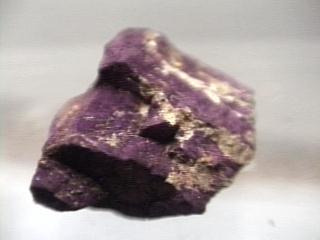
PURPURITE specimen pur-1
$ 60.00
$ 60.00
Dims: 2" x 1-1/2" x 1"
Wt: 40 g
Kola Peninsula, Russia
I'd never seen Purpurite before we got in this specimen; this is a strange mineral! Obviously, the manganese gives it its rich purple color, from which it got its name. Don't handle it too much, though, because the outer layer seems to break down into a dust that, like Limonite, tends to migrate to your hands and whatever they subsequently touch. I don't know what the material is that forms the veins running through the specimen, but there is a small amount of some type of Mica here and there on the piece. It's really quite a pretty specimen, and a rather rare one, too.

pur-1 ($ 60.00)
Kola Peninsula, Russia
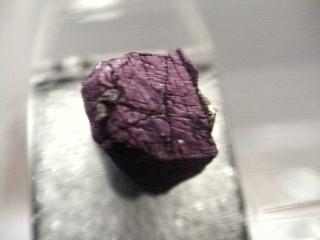
PURPURITE specimen pur-2
$ 28.00
$ 28.00
Dims: 3/4" x 3/4" x 1/2"
Wt: 9 gm
Kola Peninsula, Russia
The only way that I can describe this piece is to say that it looks like an old piece of wood that somebody rubbed a purple eye-shadow into. The luster is either satiny or sub-metallic, take your pick, and though the specimen itself looks weathered, its shape suggests that it was part of a larger crystal. I like this specimen best of all beacuse of those reasons- it has grown on me in a short period of time!

pur-2 ($ 28.00)
Kola Peninsula, Russia
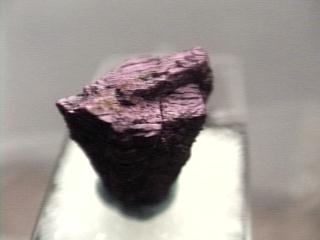
PURPURITE specimen pur-3
$ 27.00
$ 27.00
Dims: 3/4" x 3/4" x 1/2"
Wt: 7 g
Kola Peninsula, Russia
This rare specimen does not seem to show any evidence of crystal form. However, close examination shows a smattering of a dark solid in several spots on the mineral. I can only guess that it might be Manganite. I'm not sure, but I can't think of any other alternative. Anyway, it's a rare mineral, and would look great in a curio next to, say, a thumbnail specimen of Autunite for color contrast.

pur-3 ($ 27.00)
Kola Peninsula, Russia
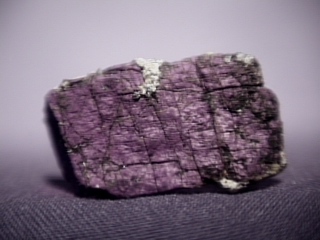
PURPURITE specimen pur-4
$ 26.00
$ 26.00
Dims: 1.6" x 0.9" x 0.4" (4.1 x 2.3 x 1.0 cm)
Wt: 12.0 g
Larimer County, Colorado, U.S.A.
This is the first Purpurite specimen we have found that comes from a U.S. locality. It is very similar to the Russian specimens that we have had in stock, though; its massive habit, violet color, dull but seemingly submetallic luster, and its powdery consistency are all the same. There are a few patches of whitish, crystalline mica attached to the Purpurite, but no host rock or other material.

pur-4 ($ 26.00)
Larimer County, Colorado, U.S.A.

PURPURITE specimen pur-5
$ 25.00
$ 25.00
Dims: 0.7" x 0.5" x 0.5" (1.8 x 1.3 x 1.3 cm)
Wt: 5.7 g
Kola Peninsula, Russia
This thumbnail specimen consists of a small piece of Purpurite. It shows no definable crystal form, and thus it is difficult to assess the amount of damage, if any, that the piece has. It possess the standard violet color with a hint of red and a dull, almost silky luster. Like other Purpurite specimens that we have had, it has a powdery consistency wherein a thin layer of violet powder will rub off when the piece is touched. There is a small amount of muscovite or some other mica attached to the piece, but no discernable host rock.

pur-5 ($ 25.00)
Kola Peninsula, Russia
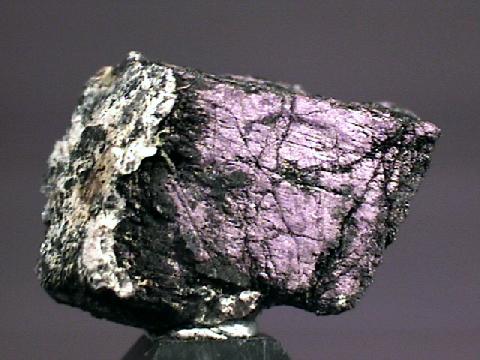
PURPURITE specimen pur-6
$ 26.00
$ 26.00
Dims: 0.8 x 0.6 x 0.4" (1.9 x 1.4 x 1.0 cm)
Wt: 5.7 g
Kola Peninsula, Russia
This small Purpurite specimen does not necessarily show a crystal form, but its general shape shows rather flat, clean surfaces that I believe are natural in occurrence. It has the standard violet coloration with a red tinge, and shows a dull, silky luster. The material has a powdery consistency; such a powder will rub off if the specimen is touched or lightly abraded. It is, of course, opaque. There appears to be a small amount of a pale brown, muscovite-laden host rock attached to one face of the piece.

pur-6 ($ 26.00)
Kola Peninsula, Russia
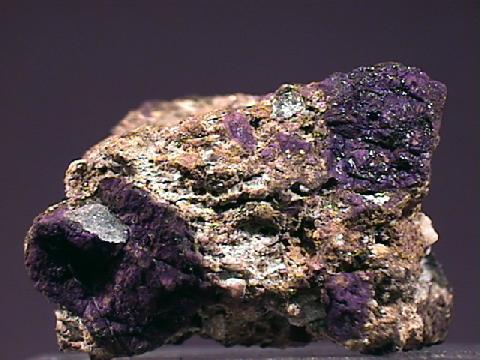
$ 57.00
Dims: 1.7 x 1.1 x 1.0" (4.3 x 2.8 x 2.5 cm)
Wt: 26.6 g
BB #7 Quarry, Norway, Oxford County, Maine, U.S.A.
This specimen is the first that I have seen wherein Purpurite "crystals" are embedded in a host rock. Actually, one can use the term "crystals", because these formations are as close to crystalline Purpurite that I have yet seen. Though all of them show some damage and many of the faces are uneven and edges are rounded, there do seem to be some definite crystalline faces and edges on them. When viewed at certain angles in the light, several of the faces show a bright, almost vitreous luster that I have never before seen on Purpurite; usually, it has a very dull, almost silky luster. These formations have the standard violet coloration and powdery consistency of Purpurite, and are embedded in a brown matrix rock that appears to be some type of conglomerate- there are tiny pieces of a variety of different materials trapped in it. I also believe that this northeastern U.S. locality is not very well-known for this mineral.
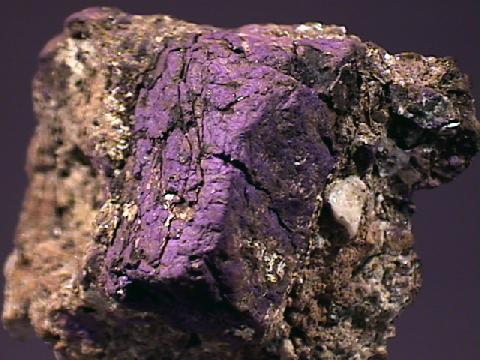

BB #7 Quarry, Norway, Oxford County, Maine, U.S.A.
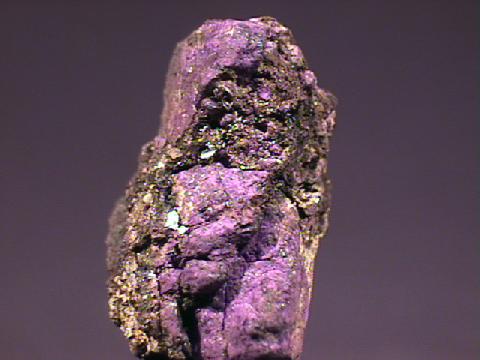
PURPURITE specimen pur-8
$ 44.00
$ 44.00
Dims: 1.2 x 0.7 x 0.6" (3.0 x 1.8 x 1.5 cm)
Wt: 11.2 g
BB #7 Quarry, Norway, Oxford County, Maine, U.S.A.
This small thumbnail specimen consists of a cluster of semicrystalline Purpurite forms. There really is no definite crystal form visible, but the general shapes of the crystals do suggest some order and symmetry in their forms. However, there is not enough to accurately assess damage. The largest of these has dimensions of 0.6 x 0.5 x 0.3" (1.5 x 1.3 x 0.8 cm). All have the standard violet color with a hint of red and the almost silky luster and powdery consistency that are hallmarks of this mineral. There is some other material visible on the piece whose color ranges from cream to deep brown, and a few tiny bits of mica.

pur-8 ($ 44.00)
BB #7 Quarry, Norway, Oxford County, Maine, U.S.A.
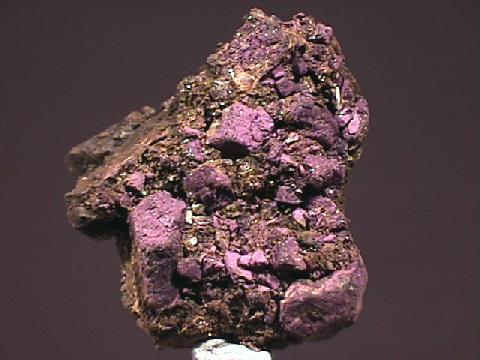
PURPURITE specimen pur-9
$ 43.00
$ 43.00
Dims: 1.1 x 1.0 x 0.6" (2.8 x 2.5 x 1.5 cm)
Wt: 7.5 g
BB #7 Quarry, Norway, Oxford County, Maine, U.S.A.
Several possible Purpurite chunks are clustered together to make up this small thumbnail specimen. I really cannot call these crystals, as only the smallest of them appear to have anything resembling a crystalline form. The "crystals" range in size from 1 or 2 mm in each dimension up to 0.6 x 0.2 x 0.2" (1.5 x 0.5 x 0.5 cm). A few of the larger crystals do appear to show some crystalline tendencies, but nothing approaches an actual form. All have the standard violet coloration with a slight hint of red, the dull, almost silky luster, and the powdery texture of Purpurite. There are veins of a brown material and small tablets of a mica between the "crystals".

pur-9 ($ 43.00)
BB #7 Quarry, Norway, Oxford County, Maine, U.S.A.
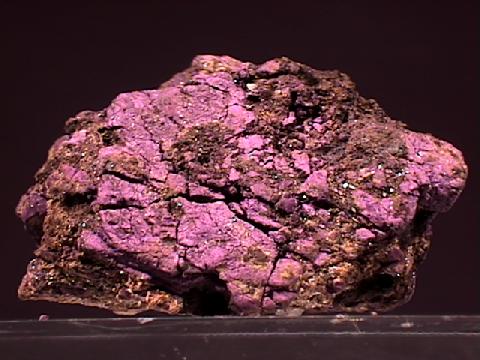
PURPURITE specimen pur-10
$ 44.00
$ 44.00
Dims: 1.3 x 1.0 x 0.9" (3.3 x 2.5 x 2.3 cm)
Wt: 20.2 g
BB #7 Quarry, Norway, Oxford County, Maine, U.S.A.
Several intergrown "crystals" of Purpurite make up the bulk of this thumbnail specimen. These bits are likely not actual crystals of the material, as they really do not show any regular form. The do not show any fresh damage, either, and so are in good condition. The Purpurite has the classic violet color with a red tinge and the dull, silky luster that suggests its slightly powdery texture. It is, of course, opaque, and shows cracks and crevices in many places. There are a few tiny muscovite blades present, along with a dull brown material that strongly resembles limonite.
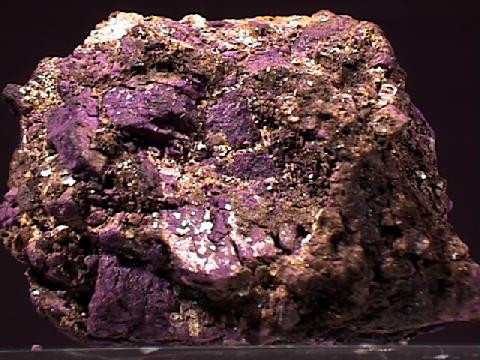

pur-10 ($ 44.00)
BB #7 Quarry, Norway, Oxford County, Maine, U.S.A.

PURPURITE specimen pur-11
$ 68.00
$ 68.00
Dims: 2.8 x 2.3 x 1.1" (7.1 x 5.8 x 2.8 cm)
Wt: 5.16 oz. (146.3 g)
Krystal Krown Claim, Larimer County, California, U.S.A.
At least 50% of the mass of this small hand specimen is made up of massive Purpurite. It has the standard violet coloration with a tiny hint of red and the dull velvet luster that is common for this mineral. The material is chalky, and even rubbing it with a fingertip will produce a small amount of powdered Purpurite. It is completely opaque and is heavily intergrown with a few other related minerals such as heterosite, sicklerite, and ferrisicklerite. There is also a small but noticeable amount of mica present, but no other host rock.

pur-11 ($ 68.00)
Krystal Krown Claim, Larimer County, California, U.S.A.

PURPURITE specimen pur-12
$ 30.00
$ 30.00
Dims: 1.5 x 1.3 x 0.6" (3.8 x 3.3 x 1.5 cm)
Wt: 25.7 g
Sandamap Mine, Usakos, Namibia
This specimen appears to consist of a chunk of nearly amorphous Purpurite that is mostly covered by a thin crust of a dark brown rock. A few "breakage surfaces" expose the manganese phosphate mineral, showing its reddish-violet coloration and its characteristic silky luster. Like most examples of Purpurite, this material is slightly powdery and will rub off onto surfaces when lightly abraded. I cannot tell how much of the piece actually consists of Purpurite, but I think that it makes up at least one-third of its mass.

pur-12 ($ 30.00)
Sandamap Mine, Usakos, Namibia
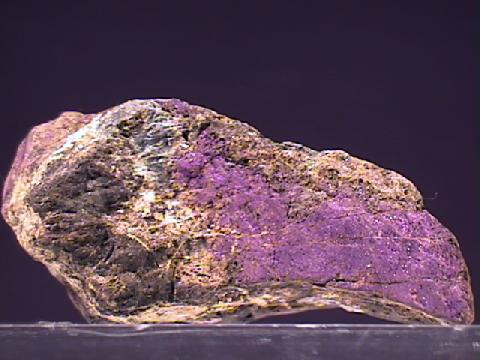
PURPURITE specimen pur-13
$ 28.00
$ 28.00
Dims: 1.6 x 1.1 x 0.7" (4.1 x 2.8 x 1.8 cm)
Wt: 25.0 g
Sandamap Mine, Usakos, Namibia
Most of the mass of this thumbnail specimen consists of Purpurite, though there is a small amount of brown host rock present. The purpurite does not appear to have a definable crystal form, and is thus in essentially good condition. It does show the classic violet coloration with a hint of red and the almost silky luster that is a common characteristic of the species. It is opaque and has a slightly powdery consistency- it will rub off a little when the piece is abraded slightly. The surrounding brown host rock is also a bit chalky, which make me think that it is made of limonite.

pur-13 ($ 28.00)
Sandamap Mine, Usakos, Namibia
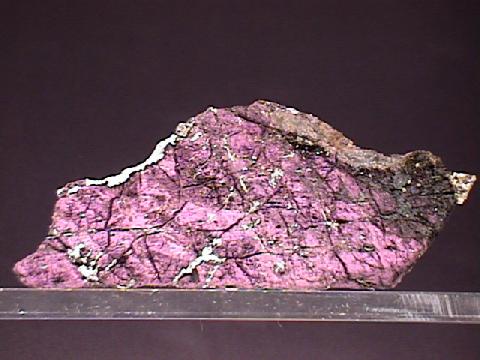
PURPURITE specimen pur-14
$ 77.00
$ 77.00
Dims: 4.2 x 1.7 x 0.8" (10.7 x 4.3 x 2.0 cm)
Wt: 2.75 oz. (78.0 g)
Colorado, U.S.A.
This hand specimen consists almost entirely of crystalline Purpurite that shows slight wear on one side. Though it does show crystalline tendencies, there is no evidence of a definite orthorhombic-based form. The material has all of the classic traits of Purpurite, including the violet color with a faint hint of red, the dull, almost silky luster, and the powdery consistency. It is permeated by veins of a dull, white material that I cannot identify, and there is some muscovite present. A small portion of the material is slightly blackened, as if it is partly permeated with a managanese oxide or other dark substance.

pur-14 ($ 77.00)
Colorado, U.S.A.
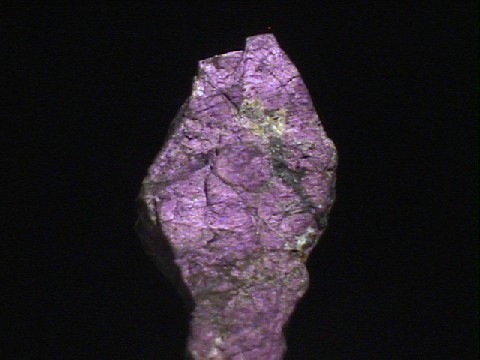
PURPURITE specimen pur-15
$ 30.00
$ 30.00
Dims: 1.4 x 0.8 x 0.5" (3.6 x 2.0 x 1.2 cm)
Wt: 12 g
Usakos, Namibia
This crystalline Purpurite thumbnail is in excellent condition but shows no definite orthorhombic form. It has the classic reddish-violet coloration and almost silky, submetallic luster. It comes in a plastic thumbnail box.

pur-15 ($ 30.00)
Usakos, Namibia
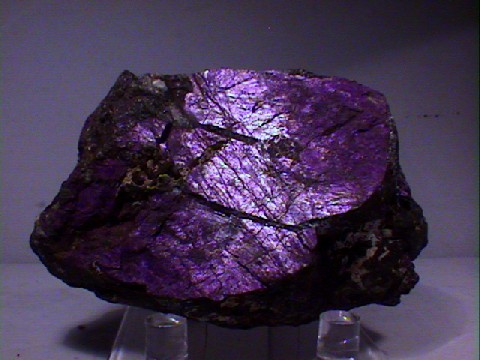
PURPURITE specimen pur-17
$ 60.00
$ 60.00
Dims: 3.6 x 2.2 x 2.1" (9.1 x 5.6 x 5.5 cm)
Wt: 12.1 oz. (342 g)
Sandamap Mine, Usakos, Namibia
This chunk of massive Purpurite shows no apparent orthorhombic crystal form, though its cleavage is obvious. It has the classic purple color and a silky, almost sub-metallic luster and is completely opaque. Veins of quartz or calcite permeate the Purpurite, and one or two books of mica are deeply embedded in one spot.

pur-17 ($ 60.00)
Sandamap Mine, Usakos, Namibia
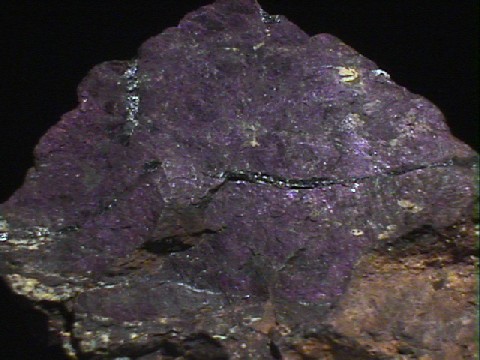
PURPURITE specimen pur-16
$ 25.00
$ 25.00
Dims: 2.2 x 1.4 x 1.2" (5.6 x 3.7 x 3.1 cm)
Wt: 2.1 oz. (59 g)
Sandamap, Namibia
This hand specimen consists of an apparently massive Purpurite chunk. It shows no appreciable crystal form and has a dull red-violet color and a dull, silky luster. A crust of another material coats one face, but I cannot identify it.

pur-16 ($ 25.00)
Sandamap, Namibia
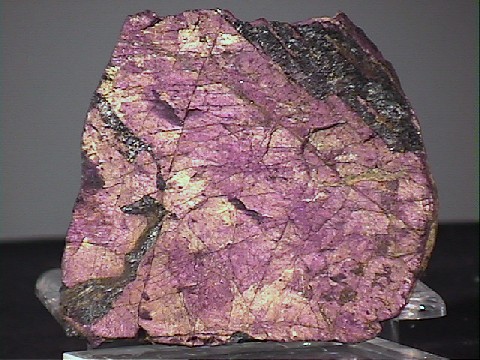
PURPURITE specimen pur-18
$ 40.00
$ 40.00
Dims: 1.5 x 1.3 x 0.6" (3.8 x 3.3 x 1.5 cm)
Wt: 4.9 oz. (138.7 g)
Sandamap Mine, Usakos, Namibia
This hand specimen is mostly Purpurite by weight. Both the front and back of the specimen show an interesting crystalline pattern. This pattern continues through the many pale patches which I suspect are of unaltered lithiophyllite. There is also a few other minerals present, including quartz veins and a black mineral which I have not identified.

pur-18 ($ 40.00)
Sandamap Mine, Usakos, Namibia

PURPURITE specimen pur-19
$ 25.00
$ 25.00
Dims: 2.7 x 1.3 x 0.7" (6.9 x 3.4 x 1.8 cm)
Wt: 1.9 oz. (34.8 g)
Sandamap Mine, Usakos, Namibia
This small hand specimen is almost entirely Purpurite by weight. It shows an interesting crystalline pattern on it's front and back. The luster of the specimen is also interesting, as from some angles the appearance is bright "purpurite" purple, from others it is a deep purple, and from one angle it appears a brownish-purple. The optical effects make it a nice specimen to hold and examine.

pur-19 ($ 25.00)
Sandamap Mine, Usakos, Namibia
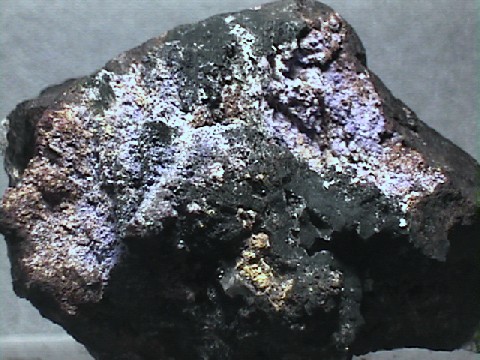
PURPURITE specimen pur-20
$ 32.00
$ 32.00
Dims: 2.5x1.7x2.0" (6.4x4.3x5.0cm)
Wt: 5.0 oz. (141g)
Sapucaia, Minas Gerais, Brazil
WHile most of the purpurite that we have had is massive, this is a sample of a purpurite crust that lines portions of the host rock. Under a 15x loupe, the crust has a good purple color, seems to look like stalactites in some areas, and at least one orthorohombic and somewhat transparent crystal is visible. The host rock is a jumble of minerals, including (I think) bornite, possibly sphalerite, psilomelane and limonite, plus some very interesting black crystals that superficially resemble schorl, but are likely something else.

pur-20 ($ 32.00)
Sapucaia, Minas Gerais, Brazil
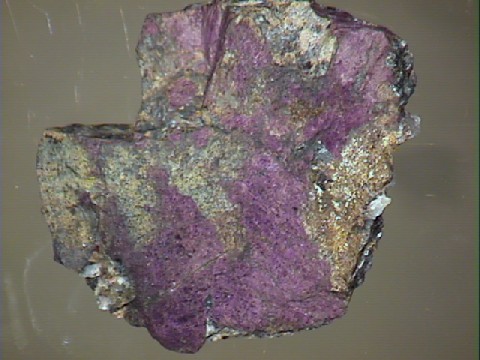
PURPURITE specimen pur-21
$ 25.00
$ 25.00
Dims: 1.61x1.50x0.66" (4.10x3.80x1.68cm)
Wt: 1.45oz (41.1g)
Sandamap Mine, Usakos, Namibia
One surface of this specimen is 50% coated with a thin (1mm) layer of purpurite. It has the typical purple color, and a rather dull luster. There is also a dusting of purpurite on much of the rest of that surface, although it is thin enough (or scattered enough) to not look purple, except with the aid of a loupe.

pur-21 ($ 25.00)
Sandamap Mine, Usakos, Namibia
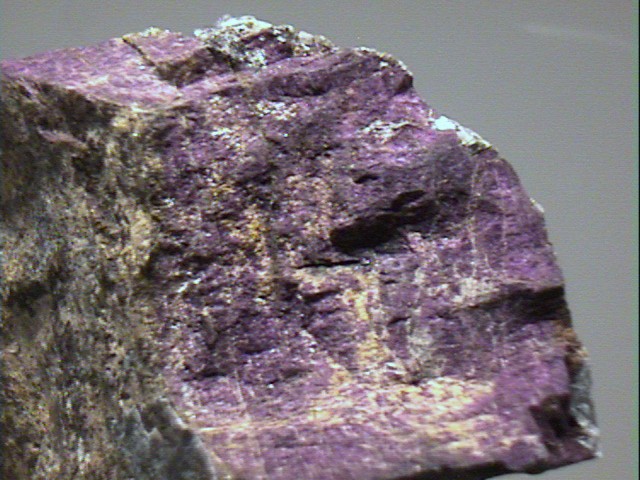
PURPURITE specimen pur-22
$ 25.00
$ 25.00
Dims: 2.00x1.24x0.98" (5.08x3.14x2.50cm)
Wt: 1.68oz (47.6g)
Sandamap Mine, Usakos, Namibia
The good news is that this specimen is nearly pure purpurite. The bad news is that most surfaces are heavily weathered to a brown color that hides the beauty of the purpurite, which is only exposed along the sides. Where visible, the color is an intense purple, with an odd luster that is dull from most angles, yet pearly from others.

pur-22 ($ 25.00)
Sandamap Mine, Usakos, Namibia
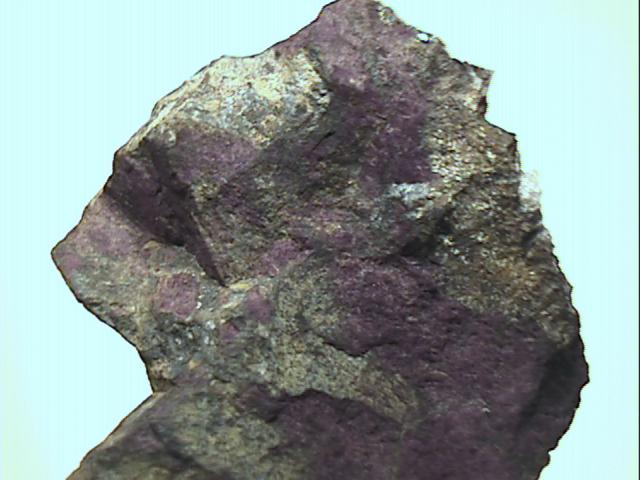
PURPURITE specimen pur-23
$ 25.00
$ 25.00
Dims: 1.86x1.61x0.49" (4.72x4.08x1.23cm)
Wt: 1.04oz (29.4g)
Sandamap Mine, Usakos, Namibia
There are indications that this specimen may be mostly purpurite, and not just a common crust over a host rock. What is clearly purpurite is, of course, purple in color, and has generally a dull appearance, but when the light strikes it a certain way, it reflects well, suggesting a sub-metalic luster. At least one crystal appears to run the length of the specimen, and while its fresh surfaces are clearly purpurite, the remainder has a dull dirty-gray (hint of green) appearance of the rest of the specimen, making me think that perhaps most of the specimen is just weathered purpurite.
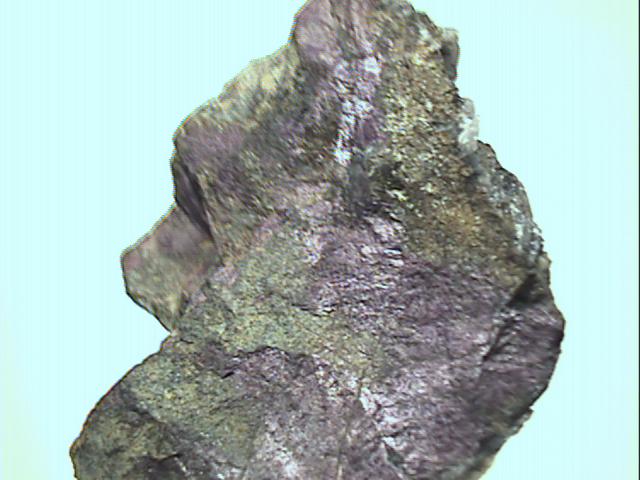

pur-23 ($ 25.00)
Sandamap Mine, Usakos, Namibia